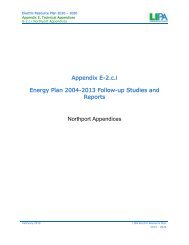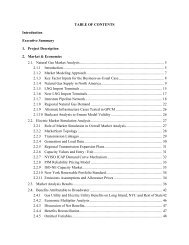Red Book - Long Island Power Authority
Red Book - Long Island Power Authority
Red Book - Long Island Power Authority
You also want an ePaper? Increase the reach of your titles
YUMPU automatically turns print PDFs into web optimized ePapers that Google loves.
2012 Edition <strong>Red</strong>book<br />
7.0 GROUNDING & BONDING<br />
7.1 Grounding<br />
7.1.1 All grounding and bonding shall be in accordance with the provisions in the latest edition of<br />
the NEC and all local, state and federal regulations.<br />
7.1.2 The grounding electrode conductor and equipment of the service entrance shall be<br />
effectively and permanently grounded in accordance with or exceeding the latest edition of<br />
the NEC or in accordance with the requirements of applicable authorities having<br />
jurisdiction where any differences occur.<br />
7.1.3 The grounding electrode conductor shall be solid or stranded, sized in accordance with the<br />
requirements of the NEC but shall in no case be less than No. 6 AWG copper or No. 4<br />
AWG aluminum or copper-clad aluminum. Use of aluminum or copper-clad aluminum<br />
conductors for grounding will only be approved when installed in accordance with the NEC<br />
and all local codes. In New York City, installation must be according to applicable City<br />
codes (e.g., #6 stranded copper in conduit.)<br />
7.1.4 All ground rods will be required to be minimum 1/2" x 8' copper weld or 5/8” x 8’ copper<br />
plated only. No galvanized rods or piping will be accepted as a grounding electrode.<br />
7.1.5 An approved ground shall be:<br />
A) A metal underground water pipe in direct contact with the earth for 10 feet or more<br />
(including any metal well casing effectively bonded to the pipe) in addition to a<br />
supplemental ground rod.<br />
B) Not less than two driven ground rods placed at a minimum of 6 feet apart when a<br />
non-metallic water piping system exists or is to be installed. A separate grounding<br />
conductor to each ground rod shall be utilized (as shown in section 11, drawing D-<br />
7).<br />
C) As outlined in the NEC, Article 250 - Grounding.<br />
7.1.6 Under no circumstances shall a gas or fuel oil piping system be used as a grounding<br />
electrode, nor should any CATV, telephone, electric or other bond wires be placed in<br />
contact with gas mains or service piping, gas meters or regulators.<br />
7.1.7 Where a continuous copper water system is installed from the street line to the interior of<br />
the building (which includes bonding of the water meter, whether located indoors or<br />
outdoors), grounding shall be accomplished by:<br />
A) Installing a grounding electrode conductor from the neutral block of the main<br />
switch to a point where the water pipe enters the building, before the first pipe weld<br />
or fitting.<br />
B) Installing a grounding electrode conductor from the neutral block of the main<br />
switch to a supplemental ground, namely, one driven ground rod.<br />
7.1.8 Where a plastic water piping system is installed from the street line to the interior of the<br />
building, grounding shall be accomplished by:<br />
A) Installing two separate grounding electrode conductors from the neutral block of<br />
the main switch to a supplemental ground, namely, 2 driven ground rods. (See<br />
Section 7.1.4)<br />
27






